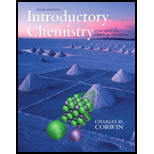
(a)
Interpretation:
The complete and balanced reaction between zinc and water is to be stated.
Concept introduction:
A balanced chemical equation represents an equation in which all the reactants and products are written with their
(b)
Interpretation:
The complete and balanced reaction between barium and water is to be stated.
Concept introduction:
A balanced chemical equation represents an equation in which all the reactants and products are written with their stoichiometric coefficient and physical states. The number of atoms of an element on the both sides of the equation is equal.
Want to see the full answer?
Check out a sample textbook solution
Chapter 7 Solutions
Introductory Chemistry: Concepts And Critical Thinking, Books A La Carte Edition (8th Edition)
- Write balanced net ionic equations for the following reactions in acid solution. (a) Liquid hydrazine reacts with an aqueous solution of sodium bromate. Nitrogen gas and bromide ions are formed. (b) Solid phosphorus (P4) reacts with an aqueous solution of nitrate to form nitrogen oxide gas and dihydrogen phosphate (H2PO4-) ions. (c) Aqueous solutions of potassium sulfite and potassium permanganate react. Sulfate and manganese(II) ions are formed.arrow_forward4.22 Generally, an excess of O2 is needed for the reaction Sn+O2SnO2 . What is the minimum number of moles of oxygen required to oxidize 7.3 moles of tin?arrow_forwardUse the terms oxidation, reduction, oxidizing agent, and reducing agent to explain the extraction of bromine from brines.arrow_forward
- . What is the oxidation state of chlorine in each of the following substances? a. CIF c. HCI b. Cl2 d. HClOarrow_forwardSodium hydroxide is added to phosphoric acid.arrow_forwardWrite the net ionic equation for the reaction, if any, that occurs on mixing (a) solutions of sodium hydroxide and magnesium chloride. (b) solutions of sodium nitrate and magnesium bromide. (c) magnesium metal and a solution of hydrochloric acid to produce magnesium chloride and hydrogen. Magnesium metal reacting with HCl.arrow_forward
- Write a balanced net ionic equation for the disproportionation reaction of (a) hypochlorous acid to chlorine gas and chlorous acid in acidic solution. (b) chlorate ion to perchlorate and chlorite ions.arrow_forwardWhat is Hrxn for reaction of iron(III) oxide and carbon monoxide to give iron metal and carbon dioxide gas? Use the following reactions: 4Fe(s)+3O2(g)2Fe2O3(s)H=1648.4kJ4CO(g)+O2(g)2CO3(g)H=565.98kJarrow_forwardThe oxidation number of Cl in HClO₂ is:arrow_forward
- Chemistry: Matter and ChangeChemistryISBN:9780078746376Author:Dinah Zike, Laurel Dingrando, Nicholas Hainen, Cheryl WistromPublisher:Glencoe/McGraw-Hill School Pub Co
 Introductory Chemistry: A FoundationChemistryISBN:9781337399425Author:Steven S. Zumdahl, Donald J. DeCostePublisher:Cengage Learning
Introductory Chemistry: A FoundationChemistryISBN:9781337399425Author:Steven S. Zumdahl, Donald J. DeCostePublisher:Cengage Learning Chemistry: Principles and ReactionsChemistryISBN:9781305079373Author:William L. Masterton, Cecile N. HurleyPublisher:Cengage Learning
Chemistry: Principles and ReactionsChemistryISBN:9781305079373Author:William L. Masterton, Cecile N. HurleyPublisher:Cengage Learning  Chemistry & Chemical ReactivityChemistryISBN:9781337399074Author:John C. Kotz, Paul M. Treichel, John Townsend, David TreichelPublisher:Cengage Learning
Chemistry & Chemical ReactivityChemistryISBN:9781337399074Author:John C. Kotz, Paul M. Treichel, John Townsend, David TreichelPublisher:Cengage Learning Introduction to General, Organic and BiochemistryChemistryISBN:9781285869759Author:Frederick A. Bettelheim, William H. Brown, Mary K. Campbell, Shawn O. Farrell, Omar TorresPublisher:Cengage Learning
Introduction to General, Organic and BiochemistryChemistryISBN:9781285869759Author:Frederick A. Bettelheim, William H. Brown, Mary K. Campbell, Shawn O. Farrell, Omar TorresPublisher:Cengage Learning Chemistry: The Molecular ScienceChemistryISBN:9781285199047Author:John W. Moore, Conrad L. StanitskiPublisher:Cengage Learning
Chemistry: The Molecular ScienceChemistryISBN:9781285199047Author:John W. Moore, Conrad L. StanitskiPublisher:Cengage Learning





